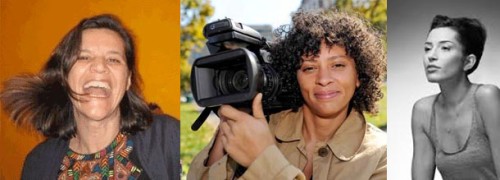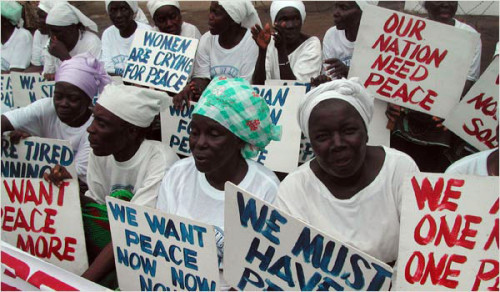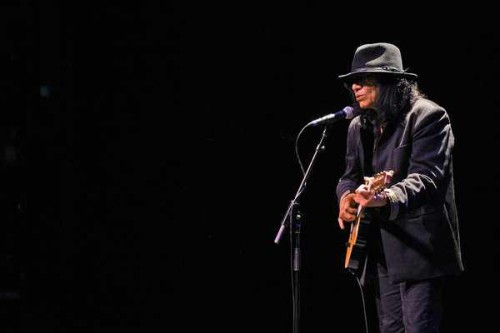
Written by Ren Jender.
The following is a transcription (edited for concision and clarity) of the first part of the panel “Below the Line” held Saturday, Feb. 7, 2015 at the Athena Film Festival. The panel featured women cinematographers Kirsten Johnson (Derrida, Pray The Devil Back To Hell, Citizenfour), Reed Morano (The Skeleton Twins, Frozen River) and Nadia Hallgren (Citizen Koch, Searching for Sugar Man) speaking with Indiewire critic Caryn James
Caryn James: There are some really appalling numbers about women cinematographers in the industry. In a study done last year by Celluloid Ceiling for the year 2013, of the 250 top-grossing films, only 3 percent had women cinematographers which was 1 percent more than the previous year and for some reason a decrease from 1998. And just to get a sense of the range here, 6 percent of those films were directed by women, 17 percent were edited by women, 25 percent had women producers. But only 3 percent of women cinematographers in that group. Why do you think that is? Are there historical reasons for that ? What is going on?
Kirsten Johnson: I was really excited to see that study. But I thought, “That doesn’t really apply to me.” Because the 250 top-grossing movies obviously we know what those movies are and there aren’t that many women. But I just came back from Sundance where I was on the US Documentary jury and you know, there are two women programmers at the Sundance Festival and I was on this wonderful jury. I did statistics on the US Documentary this year at Sundance and there were listed 19 cinematographers who were men, one cinematographer who was a woman. I went back through the numbers and out of 16 films several of them were codirected. So there were 15 men and there were eight women directors. In two of those cases the women did not list themselves as cinematographers even though they shot their own films: which is this interesting thing of a devaluation of the role and also an expectation of women in the documentary field: “I don’t have any money. I have to shoot this film myself. But I’m not really good at this. Sometime when I get some money I’ll hire someone else.” I think that’s often the case with women documentary directors who shoot their own work and certainly don’t consider it a profession.

The number that really made me sad was the subject matter of the films. So of the 16 films there were only three that had major women characters. One of those was the mother, Lucia McBath, of Jordan Davis who was shot, so she was one of an ensemble of people featured in the film. The other was How to Dance in Ohio, an ensemble piece about teenagers with autism. A couple of those teenagers were girls. And the third one was Hot Girls Wanted which was a study of amateur porn so the women who had the presence on the screen were 18-year-olds being exploited by the amateur porn industry. The rest of those 16 films, including the ones made by women, were all about men.
Caryn James; How do you account for that? Even at Sundance where you’d expect things to be more equitable. Are there historical reasons why it’s tougher for women to break into that area?
Reed Morano: I don’t know. I feel like expectations have been set up by the industry. Also it could be subconscious thinking. I mean just speaking from having made my own feature with a woman lead: it took a long time to get financing but even a longer time to get a male lead that would play second to her. I think maybe there’s a fear: you want to get the movie made, and it’s harder to get it made with a female central character.
Kirsten Johnson: I think we could break this down into several different categories. The world Reed is from is a primarily fictional world and Nadia and I are in documentary.
Caryn James: Well how did you all become cinematographers in the first place? Nadia, what was your impulse for becoming a cinematographer? Was it something you always wanted to do? Or just floundered into, the way most of us do in our careers?
Nadia Hallgren: Well I started out in still photography, black and white photography, as a kid. Someone gave me a video camera and then I started to make my own films. People seemed to respond to them. I ended up making a short film that screened at a local film festival in the Bronx, where I grew up, and I met Michael Moore’s longtime producing partner. And she liked my film. We talked and I told her I wanted to shoot films and she ended up hiring me and promised me if there was ever a chance to shoot on the film she would give it to me. And she did. That’s also how I met Kirsten who was one of DPs (director of photography) on Fahrenheit 9/11. Before we wrapped shooting I told her I wanted to be a cinematographer. I wanted her to teach me stuff and she did. It was through encounters with women that gave me an opportunity. You realize you are going to be part of this boys’ club. There were plenty of times when I was in vans with ten guys who were talking about football and I couldn’t really relate. Finding your way to other women who are supportive is key: other cinematographers, directors, producers willing to bring you in.

Caryn James: So how does that work if there aren’t all that many women in the field? Who are the people who helped you along? Who are the cinematographers who mentored you?
Kirsten Johnson: I went to film school in France. I was encouraged to go into the camera department since there was no way they were going to let an American into the directing department. I discovered cinematography. I discovered I love the camera. I moved to New York and I didn’t know anybody. I was working for the Shoah foundation interviewing Holocaust survivors. Those were all male cinematographers. One of the things in this field is: you have to fun to be with because you’re going on long trips and going to be spending long hours with people. It’s like the most important part of the job. If people want to hang out with you, they’ll hire you. And one of the other things that I learned, maybe before becoming a cinematographer, when I made this choice after college to move to Senegal because I was interested in African cinema. And I didn’t know anything, but I wanted to do it so badly. I bluffed things. I have tried to mentor folks because there was nobody to mentor me except for women directors.
When I moved to New York, there were five women who were cinematographers, like I could name all of them. They were all busy working . None of them had time to talk to me. I met with women directors like Barbara Kopple, who wanted to work with women and wanted to work with me. But I didn’t yet have that much experience. Going to Senegal and not knowing anything taught me to try. You can’t study cinematography. You learn it by doing it. And for some reason many more young men are so cocky about this, like, “I can do this. I can hold this camera.” So I started saying that too. You just say “yes” and then you learn it on the job.
Caryn James: That really is the kind of thing that speaks to the kind of confidence women should have in general. Is there something specific about working with the camera? One of the things that might have been historically factored in here was the idea that these poor, little women can’t lug around big, heavy equipment, so they shouldn’t be doing this, which is not so much the case anymore. The other thing is a lot of it is technical. You need to know science and things like lenses: not the “girly” thing to do. Is that a factor in keeping women out of that area more than other areas?
Kirsten Johnson: Well also, when you’re on a feature film you have to run a crew and most of that crew are men. So you’re the boss of men. Whereas working in documentary you’re doing it all yourself. You have to have some kind of mastery over the actual camera. But you can sort of practice that and get that under your belt. But I think in the case of features…

Reed Morano: You run a crew of men and also they’ll find out really fast if you don’t know what you’re doing. The only way to run a crew successfully is if you have their respect and they have confidence in you and you know what you’re talking about. You don’t have to overprove yourself, but the things you ask for have to make sense. You’re not running people around in circles. You know what you want. You’re not waffling. You make immediate decisions. I’m about to do a show right now for HBO, a pilot, with my key grip and gaffer who are probably a good 20 to 30 years older than me and they’ve been in the union forever and probably were making movies long before I was. And they’re awesome. They totally respect me and are psyched to do it.
Caryn James: How did you get there?
Reed Morano: Well personally all the films I had to do before I got into the union were with friends and peers, male or female. And you learn how to work with guys. I came up as a key grip as well which is typically, that’s a very male-dominated job. Because it’s basically heavy lifting. I remember the first time I was gripping and I had to receive a 4 x 8 feet sheet of plywood from a guy on top of a truck. I was like, “I don’t really know if I can do this. Okay, I’m doing it. And I’m not wearing (work) gloves because I’m a girl.” It was like a learning curve. And like you were saying, people have to like you.
Caryn James: What has been the turning point in your career? Has there been a moment when you really got some help or made some breakthrough that made you think “I can do this”?
Nadia Hallgren: I think the moment comes and comes. I think it’s an ongoing evolution. Being a cinematographer, every new experience kind of does that for me. I’m always surprised at what I learn and that that teaches me something about myself.
Caryn James: Did you go to film school?
Nadia Hallgren: No
Caryn James: So how did you know what to do?
Nadia Hallgren: I would stare at magazines. And I loved composition. I didn’t know why or what I was doing. It was just very attractive to me. Then I got into a photography program, a community program in the Bronx. I still didn’t understand what I was doing, but a lot of it was just watching movies, talking to people about movies, trying to understand what was happening in front of me and just doing.
Caryn James: Reed, did you go to film school?
Reed Morano: Yeah, I went to NYU and I went with the intention of writing and directing. And then when I got there, just from the very first shoot as a PA (production assistant) I just couldn’t stop watching what the DP was doing. I was like, “That must be the most amazing job,” because you make everyone see what you see. You control that. I asked everyone: to become a DP what do I have to do? And the only advice was: take every technical class. Everyone at NYU wants to be a director, so no one wants to take technical classes. Then I would tell everyone, “I want to shoot your movie.” They all didn’t care because they just wanted to be directing. So I shot a few. At the time I was in film school everything was pretty much shot on 16 mm or 35. It was a big, scary, cool moment, but everyone was in it together which was helpful and you came out of it with sort of a reel but not really. You get to make your mistakes with other students. The “doing” part of it for me was the most important part. I don’t think I really learned how to light until a few years after film school.
Ren Jender is a queer writer-performer/producer putting a film together. Her writing, besides appearing every week on Bitch Flicks, has also been published in The Toast, RH Reality Check, xoJane and the Feminist Wire. You can follow her on Twitter @renjender